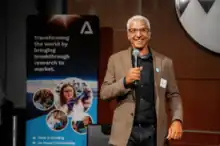Cyrus Wadia | |
|---|---|
 | |
| Education | Ph.D. in Energy & Resources (U.C. Berkeley), M.S. and S.B. in Chemical Engineering (MIT) |
| Known for | Sustainability leadership, clean-energy innovation and policy |
| Title | CEO of Activate |
| Awards | MIT Tech Review Innovators Under 35 (2009) |
Dr. Cyrus Wadia is an American leader in sustainability, materials, and innovation, with a background in science and entrepreneurship. Currently the CEO of Activate, he has previously held leadership positions at Amazon, Nike, and the White House.
Career
Wadia is the CEO of Activate, a non-profit organization that provides fellowships and associated services to scientists and engineers with the goal of bringing their research projects to the commercial market.[1]
Previously, Wadia was Director of Worldwide Product Sustainability at Amazon, where he launched Amazon's Climate Pledge Friendly badging program. As part of this initiative, he also launched Aware, a line of Amazon products that are certified as sustainable by third-party organizations.[2]
Before Amazon, Wadia was VP of Business Innovation at Nike, where he oversaw the business' sustainable innovation efforts.[3][1]
In 2010, Wadia was appointed to the White House as a science advisor to the Obama administration. He was "charged with directly supporting President Obama's mission of making solar energy economically viable on a global scale."[4] Wadia became the Assistant Director of Clean Energy and Materials R&D at the White House Office of Science and Technology Policy, where he served until 2015.[1] He played a key role in launching the Materials Genome Initiative, a federal multi-agency initiative to advance materials innovation, manufacturing, and collaboration with the mantra "twice as fast at half the cost".[5][6]
Prior to joining the White House, Wadia held a dual appointment with Lawrence Berkeley National Laboratory[7] and the Haas School of Business, where he was the co-director of Clean Tech to Market and a guest scientist.[8][9]
Innovation in solar technology
As a researcher at the Lawrence Berkeley National Laboratory, Wadia developed technology that utilized abundant materials to synthesize nanocrystals for cheaper photovoltaics. He then fabricated new solar cell devices that were much less expensive than conventional silicon-based solar cells.[10] His ultimate goal was to use this technology to lower the cost of solar energy enough that it could become the dominant power source.[8]
In 2009, Wadia was named one of MIT Technology Review's Top Innovators under 35 for his innovation in solar-cell materials.[4] The Review cited his economic analysis of materials with both good electrical properties and that could effectively absorb sunlight, identifying two previously overlooked materials: iron pyrite and copper sulfide.[11]
Also in 2009, Wadia delivered a talk "How to Bring Solar Energy to Seven Billion People" at a Lawrence Berkeley National Laboratory event, now a viral YouTube video.[10]
Among multiple published papers,[12] Wadia authored "Materials Availability Expands the Opportunity for Large-Scale Photovoltaics Deployment," a roadmap of low-cost alternatives to conventional materials used in solar cells, for the American Chemical Society publication Environmental Science & Technology in 2009.[13]
In 2013, Wadia was granted U.S. Patent 8,425,865 for his method of synthesizing pyrite nanocrystals (a.k.a. fool's gold) as a non-toxic and naturally occurring candidate for photovoltaic material.[14]
Education and scholarship
Wadia earned a Ph.D. in Energy & Resources from U.C. Berkeley,[4] and holds both an M.S. and S.B. in Chemical Engineering from MIT.[15]
Wadia has published 21 peer-reviewed papers.[12]
References
- 1 2 3 "Activate names Cyrus Wadia as CEO, opens 2024 applications - InnovationMap". houston.innovationmap.com. Retrieved 2023-12-21.
- ↑ "Aware: Inside Amazon's new private label for sustainable goods | GreenBiz". www.greenbiz.com. Retrieved 2023-12-21.
- ↑ "What the circular economy's early days look like for Amazon and Nike | GreenBiz". www.greenbiz.com. Retrieved 2023-12-21.
- 1 2 3 "Energy Institute's Cyrus Wadia to Advise White House". Haas News | Berkeley Haas. Berkeley Haas Newsroom. 2010-02-12. Retrieved 2023-12-21.
- ↑ Materials Genome Initiative: Three Years of Progress, retrieved 2023-12-21
- ↑ "Materials Data For The Masses". Chemical & Engineering News. Retrieved 2023-12-21.
- ↑ "Fueling the Future". Cal Alumni Association. Retrieved 2023-12-21.
- 1 2 "Mining Fool's Gold for Solar". MIT Technology Review. Retrieved 2023-12-21.
- ↑ ABC7. "Industries scrambling for alternatives to silicon | ABC7 San Francisco | abc7news.com". ABC7 San Francisco. Retrieved 2023-12-21.
{{cite web}}: CS1 maint: numeric names: authors list (link) - 1 2 How to Bring Solar Energy to Seven Billion People, retrieved 2023-12-21
- ↑ "Cyrus Wadia". MIT Technology Review. Retrieved 2023-12-21.
- 1 2 "Cyrus Wadia". scholar.google.com. Retrieved 2023-12-21.
- ↑ Wadia, Cyrus; Alivisatos, A. Paul; Kammen, Daniel M. (2009-03-15). "Materials Availability Expands the Opportunity for Large-Scale Photovoltaics Deployment". Environmental Science & Technology. 43 (6): 2072–2077. doi:10.1021/es8019534. ISSN 0013-936X.
- ↑ US8425865B2, Wadia, Cyrus & Wu, Yue, "Method of synthesizing pyrite nanocrystals", issued 2013-04-23
- ↑ "3 from MIT among Technology Review's top young innovators". MIT News | Massachusetts Institute of Technology. 2009-08-18. Retrieved 2023-12-21.